Letter to the Editor: Term Limits Are A Hallmark of the Democratic Process
- Details
- Written by: Cynthia Roberts
- Hits: 2044
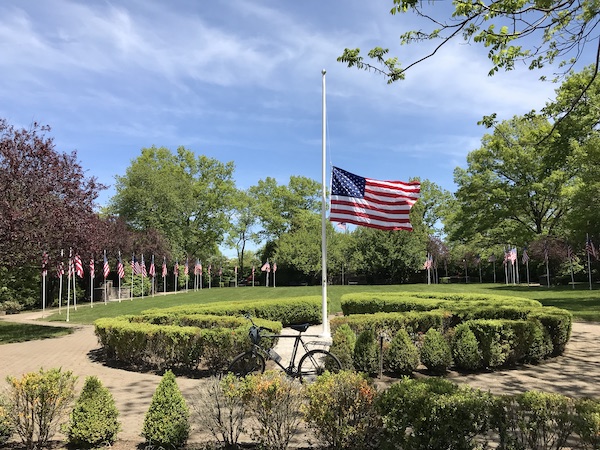
Dear Mayor Arest and Members of the Board of Trustees,
Many thanks to you all for serving countless hours as volunteers for our community. I listened with great interest to the March 12, 2024 hearing on the proposal to eliminate term limits for the volunteer members of the Board of Architectural Review (BAR) and the Committee on Historic Preservation (CHP) who can currently serve up to two 3-year terms, for a total of six years.
I respectfully write in strong opposition to the proposal to eliminate term limits for the BAR and CHP. Term limits are a hallmark of the democratic process. We must ensure that our positions of power in Scarsdale are open to participation by a resident base that is constantly refreshed with new people and new ideas. Allowing the same persons to stay in power indefinitely serves as a disincentive to resident engagement and sets a dangerous precedent. Scheduled changes of membership, in contrast, enriches these decision-making bodies bringing more diverse perspectives, wisdom and experience.
Your well-intentioned reasons for eliminating term limits include a fear of losing current volunteer members of the BAR and CHP too soon after they have been trained and gained experience. Another rationale you mentioned was addressing the problem of member absence at officially scheduled meetings. Finally, you spoke about the importance of institutional memory.
You know that the first years on the job bring tremendous learning. Yet Trustees stay in office for no more than four years. Our own Mayors serve a maximum of six years on the Board of Trustees. This Trustee turnover helps sustain public trust. Eliminating term limits for the BAR and CHP would mean that members who have already served six full years could serve many more years.
In terms of training, I suggest that volunteers participating in these important governmental roles undergo mandatory training that would at minimum include a review of their statutory mission, all official relevant guidance documents, and all relevant Village codes and procedures. In addition, it would be important for the volunteers to understand the overall land use processes, including the roles of the Planning, Building and Engineering Departments, as well as how the decisions of each volunteer body impacts the other bodies.
Training sessions on Department roles, Village land use procedures and relevant Village codes could be held simultaneously for new members of the Board of Trustees and all other Boards, Councils and Committees where topics are relevant. Sitting members of any body should have the option to attend as a refresher.
You also cited the failure of members to attend official meetings as a rationale for eliminating term limits. If member attendance at meetings is a problem, please deal with this directly. Perhaps the requirement of mandatory attendance at a certain percentage of meetings could be communicated more clearly upfront. This commitment, if violated, could be remedied via a timely meeting of the truant member with body Chair, and if necessary, with the Board of Trustees liaison to that body. Solving an attendance problem by making our system less democratic seems to overshoot the mark.
Finally, the need for maintaining institutional knowledge was also mentioned at the hearing. Institutional knowledge is of great value, and fortunately we have a professional Village staff. There should be a knowledgeable staff person at every BAR meeting who has a comprehensive understanding and familiarity with our Village codes and procedures. This staff member can be called upon to answer questions and can serve as a valuable institutional resource to help these bodies function well.
As you well know, Scarsdale is at a tipping point. The BAR and CHP sit at the epicenter of ongoing struggles that will determine the future physical manifestation of Scarsdale’s values. Our residents have opinions about historic preservation, the aesthetics of our housing stock and neighborhoods, and the significant environmental degradation occurring due to tree loss and unprecedented flooding. To ensure ongoing confidence in our governmental bodies, the public must have confidence that they are both accessible and as democratic in structure as possible.
I urge you not to compromise confidence in our local government. Please maintain our current term limits for the BAR and CHP.
Sincerely yours,
Cynthia Roberts
15 Autenrieth Road
Scarsdale, NY 10583
(Photo Credit: Memorial Garden by Jonathan Mark)
SFCS Seeks New Board Members
- Details
- Written by: Joanne Wallenstein
- Hits: 2526
 Are you interested in joining the Board of a non-profit organization right here in Scarsdale? Are you passionate about supporting families and individuals in our community? The Scarsdale Edgemont Family Counseling Service (SFCS) is looking for enthusiastic and dedicated individuals from the Scarsdale/Edgemont community to join our Board of Trustees.
Are you interested in joining the Board of a non-profit organization right here in Scarsdale? Are you passionate about supporting families and individuals in our community? The Scarsdale Edgemont Family Counseling Service (SFCS) is looking for enthusiastic and dedicated individuals from the Scarsdale/Edgemont community to join our Board of Trustees.
As a Board member, you'll play a vital role in guiding and shaping our organization's mission to be a hub for family growth and learning.
What is SFCS? Scarsdale Edgemont Family Counseling Service is a voluntary, not-for-profit family counseling agency. With over a century of service to the Scarsdale community, SFCS has been a cornerstone, offering counseling services, social programs, and crucial initiatives like our Scarsdale Action for Youth (SAY). In addition to counseling services, the Agency provides social service programs for Scarsdale residents across the life cycle from social skills groups for young children to leadership training programs and adventure trips for teens, to facilitated monthly discussion groups for parents with kids in 5th-12th grades, to aging in place services for older residents.
Why Join Us?
• Make an Impact: Your involvement directly contributes to supporting families at every stage of life.
• Community Engagement: Connect with like-minded individuals dedicated to the betterment of Scarsdale and beyond.
• Personal Growth: Gain valuable experience and insights in nonprofit governance and community leadership.
Who Are We Looking For?
We welcome Scarsdale residents with diverse backgrounds and experiences who are committed to our mission.
How to Apply: Interested in becoming a part of our Board of Trustees? Apply by March 22, 2024 by sending a short email with the following information to [email protected]
1. Volunteer/Professional Background
2. Community Experience in Scarsdale/Edgemont
3. Experience with SFCS
Join us in creating positive change in our community! Together, we can make a difference in the lives of Scarsdale families and individuals.
Thanks for your time and consideration.
The SFCS Nominating Committee
Scarsdale Juniors Descend on College Campuses for February Break
- Details
- Written by: Leo Wetzstein
- Hits: 2548
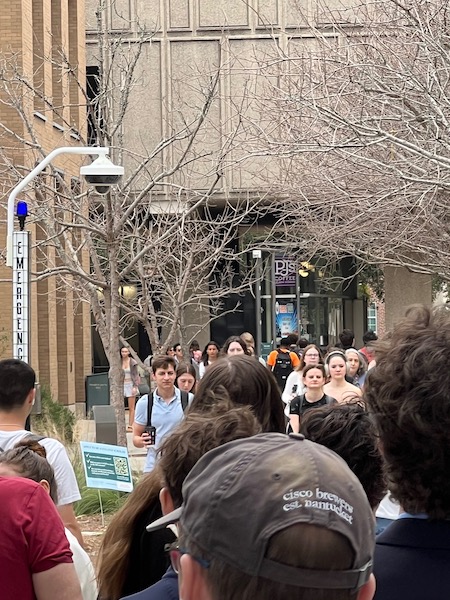
Visiting campuses before applying to a particular school is a common practice, and some schools even give preference to students who “show interest” by making the effort. While there, students seek to discover whether or not the school align with their wants and needs for location, living spaces, classrooms, facilities and the overall culture. Staying a night or two in the city or town of a school can provide an authentic experience of campus life. One Scarsdale junior who traveled to Pennsylvania schools over break, explained his interest in “what there is to do, class size, food, social life, programs and majors.” It seems that in person answers to these simple questions can make or break a student’s interest in the school.
Another student had a full itinerary that entailed flying to Saint Louis, Missouri - driving to Nashville, Atlanta and Durham, and then boarding another flight to Chicago. He felt it was worth the effort to see the campuses in person and figure out “whether it was a good fit for [him], or whether [he] could see [him]self going there” He visited schools as varied as Washington University, Vanderbilt, Emery, Davidson, Duke and Northwestern, looking for a mid-size school with challenging academics, “where kids could still have a lot of fun.”
I visited Tulane University located near the Garden District of New Orleans, across from Audubon Park. The mid-size D1 school is large enough to feel expansive, yet small enough that you could bump into people you know each day. The campus is impressive, with historic and modern buildings mixed throughout. They offer a variety of opportunities for students to get involved with the greater New Orleans community through a service component of their studies. I enjoyed my time in New Orleans as well. The city has an impressive combination of historical significance, unique culture, amazing food and music. I saw the iconic Preservation Hall Jazz Band, ate beignets at Cafe Du Monde and learned about the rich history of New Orleans on a walking tour of the French Quarter.
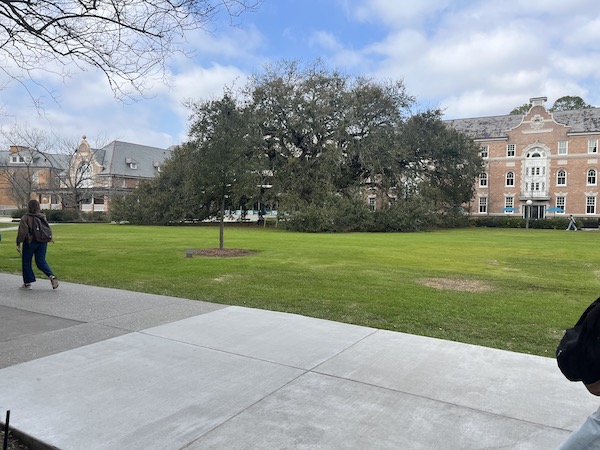
Travelling to Virginia, I visited a small school on a gorgeous campus and while I found the academic structure and teacher to student ratio really appealing; I now prefer a less secluded, city setting. My own experience led me to realize that I much prefer a mid-size to larger school within a lively city.
No matter how different the schools are that SHS students choose to visit during February break, one thing you can count on is bumping into at least one other Scarsdale Raider on your campus tour.
Candidate and Current Village Trustee Ken Mazer Looks for the Best and Highest Use of Village Funds
- Details
- Written by: Joanne Wallenstein
- Hits: 2679
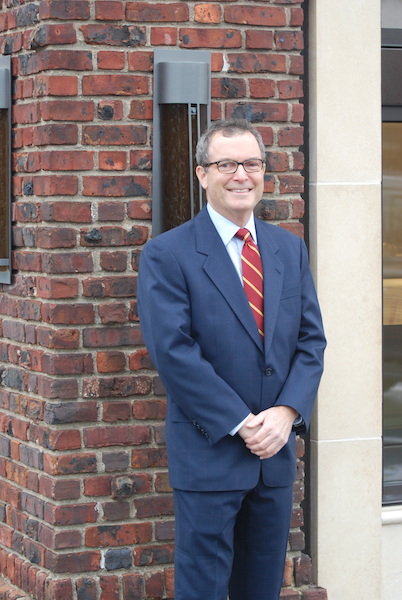
Introduce yourself to those who may not know you. What do you like about living in Scarsdale? How were your first two years as trustee and why did you decide to run again?
I have lived in Scarsdale for 27 years. In addition to completing my first term as Scarsdale Village Trustee, for the past 24 years I have been a member of the Scarsdale Volunteer Fire Department.
I grew up nearby in Harrison and received my BA from the University of Vermont and MBA from NYU. I live in Fox Meadow with my wife Melissa and have three children, ages 12, 14 and 24. Professionally, I run a business I started 20 years ago producing and importing textile products from Asia.
What impresses me most about Scarsdale is the high level of volunteerism throughout our community. Hundreds of residents commit countless hours to improve our schools, recreational activities, public safety and village government. And it shows. Scarsdale is a great place to live and raise a family.
It’s been an honor and a joy to serve on the Village Board. Addressing village-related problems, crafting sensible solutions and balancing the needs of conflicting constituents has been enormously satisfying.
Tell us what developments/accomplishments from your first term you are most proud of?
As Chair of the Personnel Committee, I was responsible for staffing our almost 20 Boards and Councils that oversee so many key functions of our village, from land-use, to sporting activities to cultural engagements, to quality-of-life initiatives. We cast a wide net to attract a deep pool of qualified candidates and ultimately filled 85 vacancies with impressive volunteers.
As Vice-Chair of the Infrastructure Committee, I supported the passage of the Sewer Lateral Law, which mandates homeowners, before selling their home, cure any leaks and dismantle any illegal sump-pumps that can collectively overwhelm and cause back-ups to the sanitary sewer system during powerful storms. While I recognized the inconvenience this would cause to all homeowners – and some complained about the hassle and cost, I appreciated the benefits it would have on sewer management, a critical challenge for our village. In the end it was clear to me that all residents needed to roll up their sleeves and do their part to help manage our stormwater problems.
Similarly, I was pleased when the board agreed to increase capital expenditures to make up for low spending in prior years, even if it meant slightly higher taxes. For example, we accelerated the paving schedule to finish resurfacing all of Scarsdale’s 80 miles of roads within 3 years. In another example, we just renovated 4 ballfields with updated infields that will result in better drainage and overall play starting this spring.
In your view, what are some of the major issues and decisions facing the Village Board this year?
The Pool: Our pool complex has outlived its expected service life and needs to be replaced. We’ve polled the community for input, consulted engineers on cost, and have determined the most practical upgrade is to replace it with another seasonal facility. An independent ad-hoc committee of community volunteers representing all constituencies of the village has been formed to oversee the design and redevelopment process. A key component of their work will be to seek feedback from the public for each step of the design process. Since I am not a part of the ad-hoc committee, I cannot comment on the forthcoming designs. But what I can say, is that, designs aside, the Board is committed to a financially sensible complex that will serve all of Scarsdale, from our very youngest to our most senior.
Land-Use Regulations: There is an overwhelming sentiment throughout the village that our land-use regulations have not kept up to date with the trends in real estate development and the impact of climate change. Accordingly, the board has hired a consulting firm with the necessary expertise to recommend enhancements to our regulations that will help our land-use boards work more closely together, enhance our greenery, better manage our stormwater runoff, and improve our new housing stock so it blends in better with our community. To give breathing room for the consultant’s work and the implementation of the revised codes, the Board has initiated a temporary 6-month moratorium on certain development activities.
Downtown Revitalization: The Board continues its work to make our downtown more of a focus in people’s lives. At the same time, we are addressing traffic flows downtown, and on Sprague Road, to make these thoroughfares safer and more welcoming to bicyclists and pedestrians. We hired a consulting firm experienced in these types of community revitalization projects. Our goal is to make the village more central in our daily activities, with appealing retailers and restaurants, parkland space, community programs and special events, all safely assessable by car, bike or foot. Trial traffic calming initiatives are scheduled for installation later this year for public comment.
New Village Manager: An active search is underway for a permanent Village Manager. The Board hired a search firm led by a women with extensive knowledge of municipal governments throughout Westchester county and who knows the industry players well. The Board will keep the community updated with important developments throughout the process.
In your first term Scarsdale lost its Village Manager. Did the absence of a Village Manager prevent the Board from moving forward on any initiatives? When do you think a new one will be installed and how do you envision his/her role?
The village is in extraordinarily capable hands. Our department superintendents and managers have decades of experience in the village and their work continues unimpeded. Our Acting Village Manager has shown an organizational oversight, dedication and wisdom of a seasoned pro. Until a permanent Village Manager is installed, the business of Scarsdale is “business as usual.”
I cannot predict when the permanent Village Manager will be selected, but I expect we will make substantial progress in the coming months. I envision her / his role will be to lead the village’s professional staff in implementing the strategic objectives established by the Board of Trustees, whose judgment is informed by our residents, our Boards & Councils, the Scarsdale Forum, and, of course, our professional village staff.
Stormwater management and flooding have been on the agenda of many meetings. Please discuss what the Village government can do and what else can be done to safeguard residents’ homes and public property.
Stormwater flooding has been an ongoing problem that the village has been addressing for many years. Exacerbated by more frequent and severe storms, our aging infrastructure is not up to the task.
The village has been undergoing a process of inspecting and repairing our existing pipeline network to make our sanitary and storm water drainage systems as efficient as possible. Partially complete, this effort will continue for several years. In addition, the newly enacted sewer lateral law, that I discussed previously, will help mitigate the impact of increased storm water on our sanitary sewer system.
Depending on the success of these measures, more aggressive plans prepared by the Department of Public Works could be considered. These call for adding upstream storage ponds that release captured storm water slowly, over many days, so that our drainage network is not over-taxed. Examples of such ponds already installed include the ones at George Field Park and across from the Public Safety Building. In addition, the proposals include upsizing the village’s culvert capacity to accommodate more storm water runoff. These plans, however, could potentially cost over $10 million. Funding at this level has not yet been considered by the Village Board.
The Board of Trustees ran a pilot program to provide pickleball courts on the Crossway Tennis Courts. How was the response? Do you think the Village will convert the tennis courts or build pickleball courts?
Recognizing the runaway popularity of pickleball, the Village Board is committed to making this sport available to our residents. In an effort to introduce pickleball, the Board identified Crossway Field as the most logical site for permanent courts, given the demands of space and parking, and considering the distance to adjacent homes. But to be sure the impact on the surrounding community was minimal, the Board first established trial courts by temporarily taping over tennis courts this past fall. With the trial up and running, the Parks, Recreation and Conservation Department carefully measured the participation rates, the impact on traffic & parking, and the noise emanating from the courts. Using decibel measuring devices, the sounds of the game were measured courtside, in back behind the noise-mitigating fencing and foliage, and further up by the little league field, where homes are nearby.
While the Board awaits a formal report and recommendations from the PRC, it seems Crossway, near the existing tennis courts, remains a promising location to install Scarsdale’s first permanent pickleball facilities.
This year the Board was faced with challenges to our land use code and preservation code from residents, realtors and developers. We currently have a six-month building moratorium in place. Share your views on these issues and what you expect the Village Board to do as an outcome of this pause.
As I mentioned previously, there is an overwhelming sentiment throughout the village that our land-use regulations have not kept up to date with the trends in real estate development and the impact of climate change. Accordingly, the Board has hired a consulting firm with the necessary expertise to recommend enhancements to our regulations that will help our land-use boards work more closely together, enhance our greenery, better manage our stormwater runoff, and improve our new housing stock so it blends in better with our community. To give breathing room for the consultant’s work and the implementation of the revised codes, the Board has initiated a temporary 6-month moratorium on certain development activities.
It is my hope and expectation that after considering the consultant’s report and receiving input from the community, the Board will make practical adjustments to our land-use and preservation codes that will prepare Scarsdale for the years ahead in way we can all support.
The Village is currently considering a proposal from the Scarsdale Business Alliance for $75,000 to fund an Executive Director. What are your views on public funding of private groups? What precedents might this decision set for future boards?
The Scarsdale Business Alliance is a compelling organization as its mission closely aligns with village objectives and our downtown revitalization initiative. That organization’s short-term grant request, however, needs to be evaluated in the context of other village priorities competing for our limited discretionary funds.
For me, the question of public funding of private groups revolves around what’s best for Scarsdale, and needs to be addressed on a case-by-case basis. The best and highest uses of our funds will vary over time depending on our community’s needs, spending opportunities and the funds on-hand. Whatever is decided about the Scarsdale Business Alliance should have no bearing on the potential future funding of private groups that benefit the residents of Scarsdale.
Scarsdale Teen Stars in Appropriate on Broadway
- Details
- Written by: Joanne Wallenstein
- Hits: 5357
 We’ve been following Alyssa Marvin for years, so when we found her name in the Playbill of “Appropriate” on Broadway, we decided it was time to catch up. Turns out that Alyssa has been very busy since she booked her first off Broadway show at the age of six and then toured Asia in “Annie” at eight. She made her Broadway debut in Gray House in 2023.
We’ve been following Alyssa Marvin for years, so when we found her name in the Playbill of “Appropriate” on Broadway, we decided it was time to catch up. Turns out that Alyssa has been very busy since she booked her first off Broadway show at the age of six and then toured Asia in “Annie” at eight. She made her Broadway debut in Gray House in 2023.
Now 15 years old, Marvin plays the role of Cassidy, a precocious tween caught in the drama of a dysfunctional family dissembling their father’s dilapidated plantation home in Arkansas. Cassidy appears alongside a veteran cast that includes Sarah Paulson, Corey Stoll and Ellen Fanning. As the story progresses, the characters become increasingly unhinged in their attempts to right their wronged relationships and salvage anything that’s left of the estate.
It's an intense drama to watch, and we assume an even more difficult play to perform, especially when you’re only 15. We reached out to Marvin with some questions about her career and the play and here is what she shared.
How did your parents recognize your passion for acting and how did you develop your talents?
When I was around four years old I went to see my first Broadway show (Annie) and I desperately wanted to be ON the stage! After that, my mom signed me up for local theater classes near Scarsdale at Random Farms Kids Theater and Sandbox Theatre, where I developed my love of performing. Since then, I’ve done many shows locally as well as professionally. I booked my first off-Broadway show when I was six, at eight I toured Asia in Annie directed by Martin Charnin, and then went on to tour the United States and Canada with School of Rock during 4th and 5th grade. During middle school, I worked on an off-Broadway musical called Trevor: The Musical, which is now streaming on Disney+! Earlier this year, I made my Broadway debut in the psychological thriller Grey House directed by Joe Mantello. Outside of working, I think training is essential. I train constantly - I take voice lessons, multiple acting classes, and dance classes in the city each week.
 Alyssa Marvin and Elle Fanning
Alyssa Marvin and Elle Fanning
Tell us about your education - did you attend Scarsdale Schools initially? And what are you up to now?
I have been in and out of Scarsdale schools since I started working during elementary school. When I’m not working on a show, I go to Scarsdale schools. For example, I did the first half of 9th grade at SHS before I booked Grey House. When I’m working, I do a fully asynchronous online program called Laurel Springs that works with my theater schedule. Child performer laws require schooling every school day, so I either school at home doing my online program or do it with tutors at the theater (depending on how many hours I am there for on a given day). I’m currently taking a full course load online similar to what I would have taken in 10th grade at Scarsdale - chemistry, algebra and even two AP classes. It’s definitely a challenge to keep up with school and perform eight shows a week, so I try to do my assignments whenever I can like backstage before the shows.
Describe your daily schedule on a day the show is on. How do you get to and from the theater - and what time do you finish at night?
Normally, I start the day doing school work at home, if it’s a single show day. In the late afternoons, I usually head to the city to have a voice lesson, dance lesson, or acting class before my call time at the theater. I arrive at the theater about 45 minutes before the show - say hello to my castmates, get ready, warm-up, maybe do a school assignment. Depending on the train schedule/what time I have to be there, I either take the train to the city or my mom, dad or grandma drive me in. Post-show, I usually get picked up by one of them since it's late at night. On two show days, I basically spend the entire day/evening at the theater!
How long is the run for Appropriate?
Appropriate is running at the Helen Hayes through March 3rd.
How do you get new roles? Do you have an agent?
Lots of auditions! I have an amazing agent, so that’s how I receive auditions. Nowadays, the first audition for a project is usually a self-tape, which I do at home, but more projects are starting to return to in-person auditions for the first round (for theater especially). For Appropriate, my initial audition was in person (my mom picked me up at sleep-away camp and drove me to New York City for it) and all the call-backs were also in person.
Some of the content in Appropriate is inappropriate indeed! Tell us about your reaction to it. Is it tough to be a teen in the midst of a very grown-up and dysfunctional family story?
While some of the content in Appropriate can be tough to swallow, the message of the show is so powerful and important, and those hard parts are necessary to achieve the maximum impact. Being a teen in such an intense show can be difficult, but the entire cast and creative team is so supportive, so it was easier to navigate the hard subject matter with them by my side.
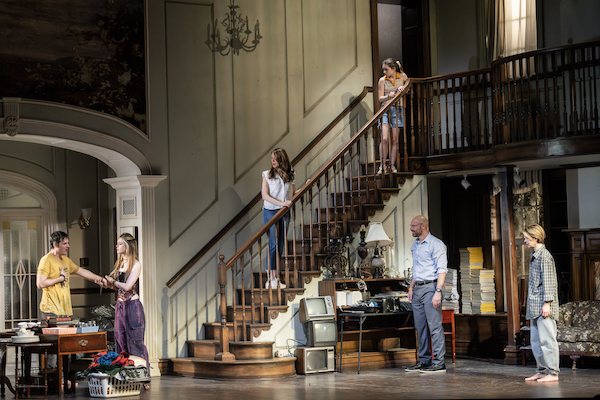 Marvin on stage with the cast of Appropriate.
Marvin on stage with the cast of Appropriate.
How have you spent your summers?
If I’m not working on a show, I go to French Woods Festival, a performing arts camp! I’ve been going there for many years (on and off depending on work), and I love it. I often self-tape auditions at camp and sometimes have to come home for them, but it works out great since it’s a theater camp, so I have plenty of people to prep with for auditions. This past summer I had expected to be working on Grey House on Broadway all summer, but when the show unexpectedly closed during July, I went to French Woods for three weeks in August. The summer before I had planned to be there for six weeks, but I booked a job while there, so I came home after three weeks to work on the project I booked. So we never know for sure what I’ll be doing each summer!
Do you take acting lessons or have an acting coach?
I take acting classes regularly for both theater and on-camera acting. Additionally, I have dance and voice lessons every week, so I can stay a well-rounded performer.
Do you miss anything about just being a student at SHS?
The thing I miss most about being a student at SHS is seeing all of my friends every day. However, I feel very grateful that I am able to stay connected to the community through the drama club and its members, so I get the best of both worlds.
What are your hopes for the future? Do you know whether or not you’ll head to college or pursue your career in NYC?
I’m not entirely sure what I will do in the future, but I know that I love acting and will certainly want to keep pursuing it on stage and screen. I’m also interested in law and psychology, so I would love to study those subjects too. I definitely will go to college and continue to act professionally!
Who are some actors that you admire or serve as role models?
I feel so lucky to be a part of the amazing cast of Appropriate, and I really admire all of the adult actors. They are all so masterful and committed to what they do, and I feel so grateful to get to learn from them every day, both on and off-stage.
What advice would you give to other kids who wish to become actors?
A piece of advice I would give to other kids who want to become actors is to always be persistent. You will receive a lot of “No’s” in this business, and it’s important to not let them get to you. Keep doing what you love, and trust it will all work out in the end.
(Update February 13: The show is transfering to the Balasco Theatre and extending through June 23 and Alyssa is staying with the show.)










